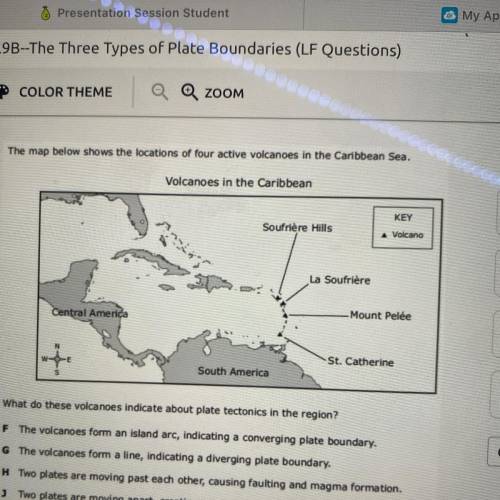
Chemistry, 21.01.2021 01:00 ccispoppin12
The map below shows the locations of four active volcanoes in the
What do these volcanoes indicate about plate tectonics in the region?
F The volcanoes form an island arc, indicating a converging plate boundary.
G The volcanoes form a line, indicating a diverging plate boundary.
HTwo plates are moving past each other, causing faulting and magma formation.
JTwo plates are moving apart, creating new seafloor


Answers: 3


Another question on Chemistry

Chemistry, 21.06.2019 22:50
Achemical reaction (also known as a chemical change) produces substances that are chemically different from the starting materials. an example of a chemical reaction is the formation of water from hydrogen and oxygen gas.in a physical change, a substance changes its physical appearance but not its chemical identity. an example of physical change is the formation of liquid water from solid water, a familiar process called melting. physically, liquid water looks very different from solid water (ice) but the chemical identity, water, is the same for both. which of following changes that affect the composition of our atmosphere involve physical changes and which involve chemical reactions? oxygen gas changes to ozone during thunderstorms carbon dioxide is produced by the combustion of gasoline in an automobile engine. when coal, oil, and natural gas are decomposed in landsills they produce methane gas. freezing rain develops when a warm air mass overrides a cold air mass. fog forms from water vapor when the temperature drops below the dew point
Answers: 1

Chemistry, 22.06.2019 03:40
Astudent is given a sample of a blue copper sulfate hydrate. he weighs the sample in a dry covered porcelain crucible and got a mass of 23.875 g for the crucible, lid, and sample. the mass of the empty crucible and lid was found earlier to be 22.652 g. he then heats the crucible to expel the water of hydration, keeping the crucible at red heat for 10 minutes with the lid slightly ajar. on colling, he finds the mass of crucible, lid, and contents to be 23.403 g. the sample was changed in the process to very light clue anhydrous cuso4. if there are again 100.0 g of hydrate, how many grams of cuso4 are in it? how many moles of cuso4? (hint: molar mass of cuso4 = 159.6 g / mole. what per cent of the hydrate is cuso4? you may convert the mass of cuso4 to moles.)
Answers: 3

Chemistry, 22.06.2019 11:00
3) in peaches, [oh]=3.16x10-11 m a) find [h+ ] b) what is the ph? c) is the solution acidic, basic, or neutral?
Answers: 1

Chemistry, 22.06.2019 11:00
Ais a mountain created from eruptions of lava, ash, rocks, and hot gases.
Answers: 1
You know the right answer?
The map below shows the locations of four active volcanoes in the
What do these volcanoes indicate...
Questions

English, 27.04.2020 03:04

Mathematics, 27.04.2020 03:04


Mathematics, 27.04.2020 03:04

Mathematics, 27.04.2020 03:04


Social Studies, 27.04.2020 03:04


Mathematics, 27.04.2020 03:04





Chemistry, 27.04.2020 03:04

History, 27.04.2020 03:04

Mathematics, 27.04.2020 03:04

Advanced Placement (AP), 27.04.2020 03:04

History, 27.04.2020 03:04


Mathematics, 27.04.2020 03:04



